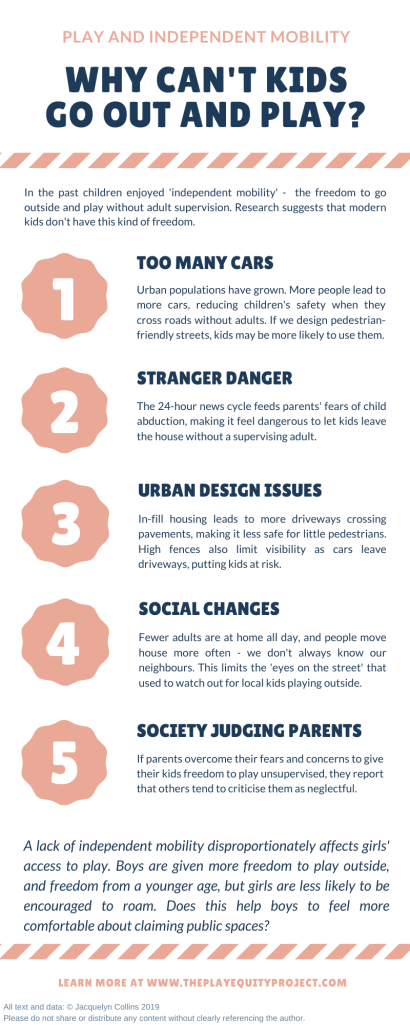
This week’s infographic draws on a synthesised literature review I produced as part of a study conducted by Patricia Austin, one of my University of Auckland lecturers, in December 2017. Tricia’s study was part of the National Science Challenge (‘NSC11’) ‘Shaping Places: Future Neighbourhoods’ project, and my specific focus area was on children’s access to play in suburban neighbourhoods. As I started my research it rapidly became clear that children’s ‘independent mobility’ – the right to roam; to leave the house without adult supervision – was an integral element that influenced access to play. And as my infographic mentions, there was also a clear difference in boys’ and girls’ independent mobility – and this is what led me to eventually focus on gender and play more broadly. So, though it may seem like this infographic is less about girls and play, and more about access to play, it still contributes to the discussion about the interface between play and gender.
Given the large number of studies I drew on for this work – over 100 published articles – it isn’t feasible to provide individual links to the contributing research, but if independent mobility is an area of particular interest to you please get in touch – I may be able to share my reference pages from the work I produced.
In 2018 I also used my access to play findings to write this article for The Spinoff, rebutting comments made by a New Zealand journalist that modern parents were ‘too soft’ because they wouldn’t let their children travel to school without an adult. If you dislike older men telling the rest of us why we’re terrible parents, you might enjoy it.
(The original infographic I uploaded in this post was replaced with a less colourful version, after some feedback that the subtle colour scheme of the original might be difficult for some visually-impaired people to read.)
I live in the US, where people might have similar discussions. Not sure that I agree with your conclusion about boys vs girls.
I can see for some boys that their behavior might be such that their parents are more likely to encourage play where they are more free to run around and aren’t likely to break anything. At least that is how it was with my kids. Not saying the girls shouldn’t be playing outside either, but my daughter wasn’t driving me crazy running around the house. I also think that in general boys suffer more for having less physical activity both within the school day and outside of it. But both girls and boys should have equal amounts of time outside and access to physical activity.
In the US I think the stranger danger element is definitely a factor. Some neighborhoods are very spread out and kids aren’t as geographically close to each other.
Yes people will judge no matter what you do.
My parents both grew up in Chicago, a large city in the US. In most neighborhoods the houses very close together. There wasn’t much as far as offerings on TV, and really it was the expectation that kids spent part of every day outside unless it was bitter cold or raining. Not everyone had cars or if they did they may have only had one car. It was just a fact of life that you would be walking or taking the bus. But they didn’t live that far from arterial streets so I am not sure that traffic was always viewed as such an issue. I think society has just changed so much.
My kids are 17 and 20, these attitudes were around when they were young. When i grew up, if the weather was good and it was still daylight I walked or biked if I wanted to go somewhere. I think it gave kids a sense of self reliance they don’t always have now.
LikeLike
Hi Kate! Thanks so much for your comments. I agree that neighbourhoods seem to have changed a lot since many of us were kids, which – coupled with broader social changes – have made it more difficult for most parents to feel comfortable with their kids running around outside without supervision.
With regard to your first point about your son and daughter, you might find a post I wrote last week interesting: Nature, Nuture, and Play. It discusses the research behind ideas that boys and girls have fundamentally different play styles, and argues that virtually all of the differences may be down to gender role socialisation influencing how children grow up and what they learn is acceptable play or behaviour for their gender. There are some differing views, but I’m pretty sure that most of the differences we see between boys’ and girls’ behaviour is less about their gender and more about how society shapes them. 🙂
LikeLike
0 Pingbacks